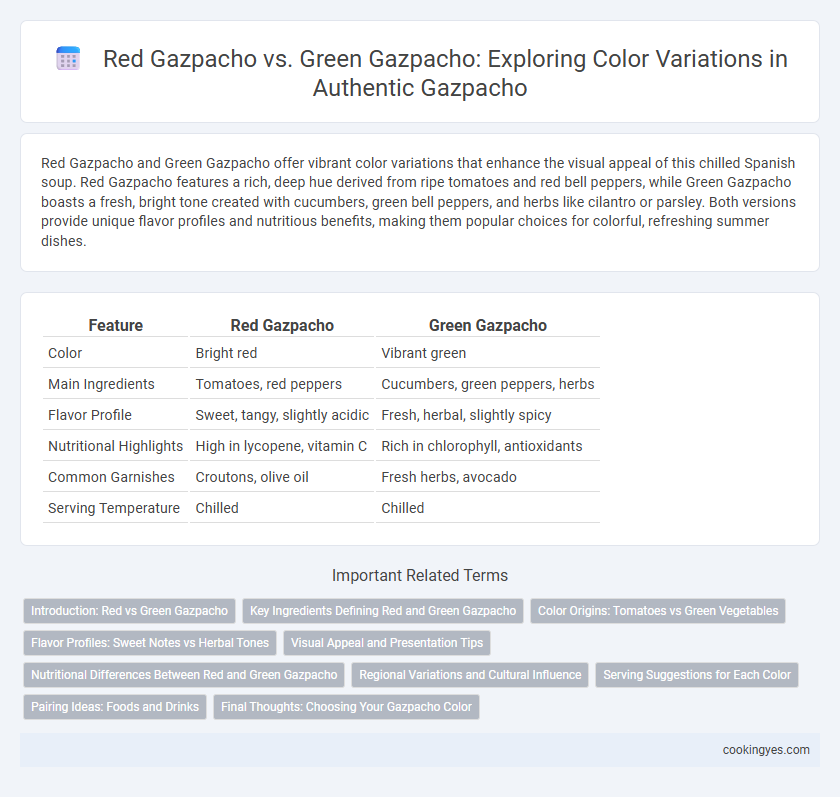Red Gazpacho and Green Gazpacho offer vibrant color variations that enhance the visual appeal of this chilled Spanish soup. Red Gazpacho features a rich, deep hue derived from ripe tomatoes and red bell peppers, while Green Gazpacho boasts a fresh, bright tone created with cucumbers, green bell peppers, and herbs like cilantro or parsley. Both versions provide unique flavor profiles and nutritious benefits, making them popular choices for colorful, refreshing summer dishes.
Table of Comparison
| Feature | Red Gazpacho | Green Gazpacho |
|---|---|---|
| Color | Bright red | Vibrant green |
| Main Ingredients | Tomatoes, red peppers | Cucumbers, green peppers, herbs |
| Flavor Profile | Sweet, tangy, slightly acidic | Fresh, herbal, slightly spicy |
| Nutritional Highlights | High in lycopene, vitamin C | Rich in chlorophyll, antioxidants |
| Common Garnishes | Croutons, olive oil | Fresh herbs, avocado |
| Serving Temperature | Chilled | Chilled |
Introduction: Red vs Green Gazpacho
Red gazpacho, made primarily from ripe red tomatoes, features a vibrant color and a sweet, tangy flavor profile rich in lycopene and antioxidants. Green gazpacho uses ingredients like green tomatoes, cucumbers, and herbs such as parsley or cilantro, resulting in a fresher, herbaceous taste with a lighter, crisp green hue. The color variation between red and green gazpacho highlights the distinct vegetable bases and emphasizes differing nutritional benefits and flavor intensities.
Key Ingredients Defining Red and Green Gazpacho
Red gazpacho features ripe tomatoes, red bell peppers, and cucumbers, which create its signature vibrant red color and rich, tangy flavor. Green gazpacho relies on ingredients like green tomatoes, cucumbers, green bell peppers, and fresh herbs such as parsley and basil for its bright green hue and fresh, herbaceous taste. The distinct use of these key ingredients not only defines the color variation but also differentiates the flavor profiles of red and green gazpacho.
Color Origins: Tomatoes vs Green Vegetables
Red gazpacho derives its vibrant color primarily from ripe tomatoes, which contain high levels of lycopene, a natural red pigment and powerful antioxidant. In contrast, green gazpacho owes its distinct hue to green vegetables like cucumbers, green bell peppers, and herbs such as parsley or cilantro, rich in chlorophyll. The differences in color origins not only influence the soup's appearance but also impart unique flavor profiles and nutritional benefits specific to their respective ingredients.
Flavor Profiles: Sweet Notes vs Herbal Tones
Red gazpacho features a vibrant blend of ripe tomatoes, red peppers, and cucumbers, offering sweet and tangy notes with a hint of garlic and vinegar for a balanced taste. In contrast, green gazpacho showcases fresh green tomatoes, cucumbers, green bell peppers, and herbs like basil and parsley, creating pronounced herbal tones and a crisp, slightly grassy flavor. The sweet notes in red gazpacho complement its acidity, while the green version highlights earthy and aromatic nuances, making each variation unique in flavor complexity.
Visual Appeal and Presentation Tips
Red Gazpacho offers vibrant hues from ripe tomatoes, creating a rich, appetizing visual contrast when garnished with green herbs or a drizzle of olive oil. Green Gazpacho, made from ingredients like cucumber, green peppers, and herbs, provides a refreshing and bright appearance, perfect for summer presentations. Serving each with complementary colored garnishes and in clear glass bowls enhances their distinct color variations, elevating overall presentation and visual appeal.
Nutritional Differences Between Red and Green Gazpacho
Red gazpacho, rich in tomatoes, provides higher levels of lycopene and vitamin C, offering potent antioxidant properties and immune support. Green gazpacho, made primarily with ingredients like cucumbers, green peppers, and herbs, delivers increased vitamin K, chlorophyll, and fiber. Both variations contribute to hydration and low-calorie intake, but the distinct vegetable profiles create unique nutritional benefits tailored to different dietary needs.
Regional Variations and Cultural Influence
Red Gazpacho, traditionally from Andalusia, features ripe tomatoes giving it a vibrant red hue, while Green Gazpacho, popular in parts of Extremadura and Catalonia, uses green vegetables like cucumbers and green peppers for its distinct emerald color. These color variations reflect regional agricultural produce and cultural preferences, with Red Gazpacho emphasizing the sun-ripened tomato harvest and Green Gazpacho highlighting early-season or garden-fresh ingredients. The cultural influence also extends to serving traditions, where Red Gazpacho is often enjoyed chilled as a summer staple, and Green Gazpacho integrates local herbs and variations, showcasing diverse Spanish culinary heritage.
Serving Suggestions for Each Color
Red gazpacho, rich in tomatoes and red peppers, is best served chilled with garnishes such as diced cucumbers, croutons, and a drizzle of olive oil to enhance its vibrant flavor. Green gazpacho, made from green tomatoes, cucumbers, and herbs like basil or parsley, pairs well with toppings like avocado slices, chopped green onions, and a splash of lime juice for a refreshing twist. Both variations benefit from a cold serving temperature to highlight their distinct color profiles and fresh, crisp textures.
Pairing Ideas: Foods and Drinks
Red Gazpacho, made with ripe tomatoes, pairs exceptionally well with crisp white wines like Albarino or Sauvignon Blanc, as well as crusty bread and fresh seafood like shrimp or oysters. Green Gazpacho, featuring ingredients like cucumbers, green peppers, and herbs, complements herbal white wines such as Verdejo or Gruner Veltliner and pairs beautifully with light salads, grilled chicken, or avocado-based dishes. For a non-alcoholic option, both variants harmonize with sparkling water infused with citrus or cucumber for a refreshing contrast.
Final Thoughts: Choosing Your Gazpacho Color
Red Gazpacho features ripe tomatoes, offering a rich, tangy flavor and vibrant crimson color, while Green Gazpacho highlights fresh cucumbers, herbs, and green peppers for a refreshing, herbaceous taste with a bright emerald hue. The choice between red or green gazpacho depends on preferred flavor profiles and presentation; red brings warmth and classic Mediterranean notes, whereas green delivers a crisp, garden-fresh experience. Selecting your gazpacho color enhances your meal's aesthetic appeal and complements seasonal ingredients for optimal taste and visual harmony.
Red Gazpacho vs Green Gazpacho for color variation Infographic

 cookingyes.com
cookingyes.com